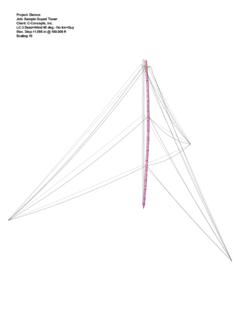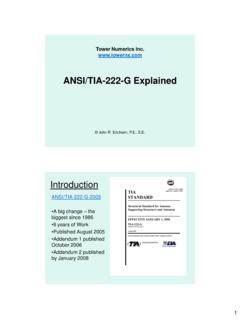Transcription of TNX Software Network Installations - Tower …
1 TNX Software Network Installations installation guide (with sentinel RMS license management Software ). Last Revised August, 2011. Tower Numerics Inc. 1050 Waltham Street Suite 430. Lexington, MA 02421. phone: 1-781-862-0966. fax: 1-781-538-6463. TNX Network installation Instructions 8/19/2011 2 of 21. TNX Network installation Instructions Network installation The installation and licensing infrastructure that Tower Numerics (TNX) uses for its Software has been originally implemented by RISA Technologies. Pursuant to the agreement between TNX and RISA, RISA provides technical support for installation issues for TNX users. However, all support requests should be initially directed to TNX These instructions are intended for the Network versions of the TNX programs. If you are running a Stand Alone version, refer to the Stand Alone installation Instructions provided with your Software . The Network version of the TNX Software has been written specifically for 32 and 64 bit Windows (XP/Vista and 7) operating systems.
2 It uses a customized version of sentinel RMS to manage and administer the licensing. The details of your Software license are contained within a license file. Therefore, you must obtain a license file from TNX and register it with the sentinel License Management server. If you do not already have a license file, then you must request one by sending an e-mail to When you e-mail your request make sure to include the Company Name, Product(s), and the Key ID. For more information, refer to section B. sub-section 1. Obtaining the Server License File. The Network version of TNX is designed such that the application itself is stored and run entirely on the Client computer. The File Server is used only to store the files for setup / installation . In addition to the file server, there must be a License Server computer that will host the license management Software . In many cases, the File Server and the License Server will be the same computer. A new or upgrade installation is a normally three part process (A, B and C) as summarized below.
3 Each step is explained in greater detail in the appropriate section. A. Perform the installation on the File Server: This involves copying data files onto the computer that will act as the File Server. This must be done for new Installations and for an upgrade /update to an existing program. Note that NO drivers are installed on the file server during this step. B. Install (or Update) the License Manager: This involves installing the license manager ( sentinel RMS) onto the License Server computer that will host the license management Software . For most cases where TNX's customized version of the sentinel License Management service is already running, this will involve a simple update rather than a full install. C. Perform the Client installation : This involves installing the program on the end user's computer. If you want to, you may set up a silent installation and initiate the Client installation through the registry or log-on scripts. For an update / upgrade to an existing program, this installation may be performed automatically.
4 When adding a new product to, or removing a product from, an existing installation , there is an additional step that will be needed. This is described in the following section. Note: Section D does NOT. normally apply when upgrading an existing product to a newer version. D. Using an RUS password to Update the Hardware Key: When adding a new product to, or removing a product from, an existing installation , you will use the TNX Key Manager utility along with the RUS password provided from either a red installation Information sheet or via email to update your sentinel Pro hardware key. In addition, we have added sections regarding some of the other administrative functions. These instructions are brief and are intended only to be a simplified introduction to the concepts. For a more 8/19/2011 3 of 21. TNX Network installation Instructions complete explanation, see the sentinel Website ( ) or contact TNX technical support E. Troubleshooting the sentinel RMS installation : Contains a brief explanation of the most common installation problems and potential solutions.
5 F. Commuting Licenses: A brief overview on how to commute licenses and control the amount of commuting that is allowed. G. Usage Reports and License Monitoring: A brief overview on how to setup usage reports regarding the use of the programs. A. Server installation . To create the necessary data files on the File Server please follow these instructions: 1) Put the TNX CD in the File Server's CD drive. 2) If the CD starts automatically go to step 4. If after 15 seconds the CD has not started click the Windows Start button and select Run. 3) In the Run dialog box type d:launch (where d is the label of your CD drive) and then click the OK button. 4) Follow the on-screen instructions. NOTE : No drivers are installed onto the file server during this step. Updating a previous version: When upgrading from a previous version that did NOT use the sentinel License Manager there will NOT be an automatic upgrade of the client computers. When upgrading from a previous version that DID use the sentinel License Manager, the client upgrades will happen automatically.
6 However, this will only occur if you maintain the appropriate sub- directory structure on the File Server. This is because an upgrade is only detected when a client computer looks at the subfolders under the ProgramServer directory. These folders will follow this naming convention: <C:\Program Files\TNX\tnxTower>\<ProgramServer>\<VersionNumber>\. Where <C:\Program Files\TNX> is the drive and base directory on the File Server for all application installs, <ProgramServer> is the directory for a TNX product, and <VersionNumber> is the directory referring to the version number for that program ( 6_00_00). The Version Number directory contains all the current installation information from that version ( ). When the program detects another subfolder ( G:\Program Files\TNX\tnxTower\TowerServer\6_10_00) it will interpret this to mean that an updated version of the tnxTower program is available. For the remainder of the instructions, the folder in which you install a program will be referred to as <ProgramServer> and the version of the program will be referred to as <VersionNumber>.
7 Locating the License Manager Files During a File Server installation of your TNX program, a \ sentinel RMS \ directory will be created under the <C:\Program Files\TNX\tnxTower> directory. This folder will contain the following files specific to the sentinel License Manager: Installs sentinel RMS as Windows service sentinel RMS (XP/Vista/7 version) executable 8/19/2011 4 of 21. TNX Network installation Instructions Required by Administers RMS server / licensing Locating the SuperPro Device Drivers During a File Server installation of your TNX program, a sentinel Protection Installer\. directory will be created under the <C:\Program Files\TNX\tnxTower> directory. This folder will contain the following files specific to the installation of the sentinel Pro device drivers: installation routine for sentinel SuperPro drivers Detailed installation instructions from sentinel Locating the Key Manager Utility During a File Server installation of your TNX program, a TNX Key Manager\ directory will be created under the <C:\Program Files\TNX\tnxTower> directory.
8 This folder contains a utility that may be used for diagnosing problems related to the sentinel SuperPro hardware key. B. Installing the License Manager ( sentinel RMS). After the File Server installation has been completed, the following steps must be taken to ensure the proper installation of sentinel License Management Software . Each step is explained in greater detail in the following sections. (The TNX customized sentinel RMS is fully compatible with RISA's sentinel RMS. Consequently, licensing of TNX and RISA programs may be administered by either version.). For cases where TNX's customized version of the sentinel RMS service is already running, this will involve a simple update rather than a full install. For most updates, only steps 1) and 4) will be required. 1) Obtain the TNX license file 2) Install the sentinel Pro device driver 3) Install or Update TNX's customized version of sentinel RMS on the License Server 4) Configure sentinel RMS License Server to work with the new license file 1.
9 Obtaining the TNX License File TNX will ship a sentinel SuperPro hardware key which will be used to secure your Network installation . Each key will have a unique KeyID. You will need to request a license file from TNX. You may do so by e-mailing with your company information, product information, and the program serial number(s) or Key ID. TNX will then send you a license file in return. The license will have a name similar to TNX_LM_KeyID , where KeyID corresponds to your USB. key. In some cases, the file may be called TNX_LM_CompanyName , where CompanyName is the name of your company. This file is a unique identifier / license file for your TNX programs. The generated license will be locked to your KeyID. Each time TNX is launched, sentinel RMS will validate the license to ensure that the key is present. This file needs to be updated for each new release or whenever you add or reduce the license count of your Network version of the TNX. program. 8/19/2011 5 of 21.
10 TNX Network installation Instructions 2. Installing the sentinel SuperPro device driver Copy the sentinel Protection Installer directory onto the License Server computer which will host the sentinel RMS Service. This computer need not be an actual server. All that is required is that it be running XP/Vista/7 and that it be on a Network that can be accessed by the client computers. MAKE SURE you remove ALL of the sentinel SuperPro and Rainbow keys from your computer BEFORE you initiate the installation . Then run the file that exists in that directory. This will launch the InstallShield Wizard for the SuperPro device drivers. Follow the on screen instructions to complete the installation of the SuperPro drivers. We recommend that you select the complete install. 3. Installing (or Updating) sentinel RMS on the License Server Installing a new sentinel RMS Service: TNX runs a customized version of sentinel RMS. If you are already running a non-customized version of sentinel RMS refer to the next section on updating a sentinel RMS service.




